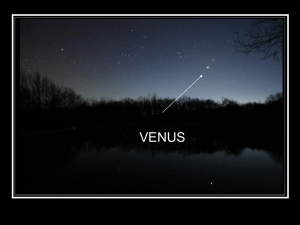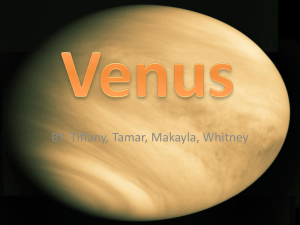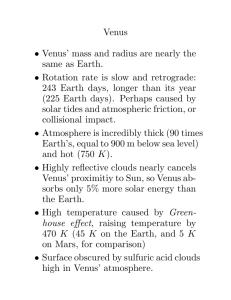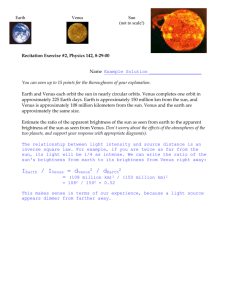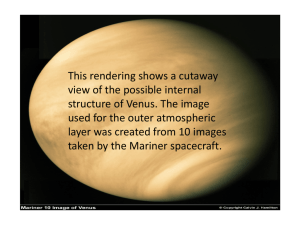File
advertisement
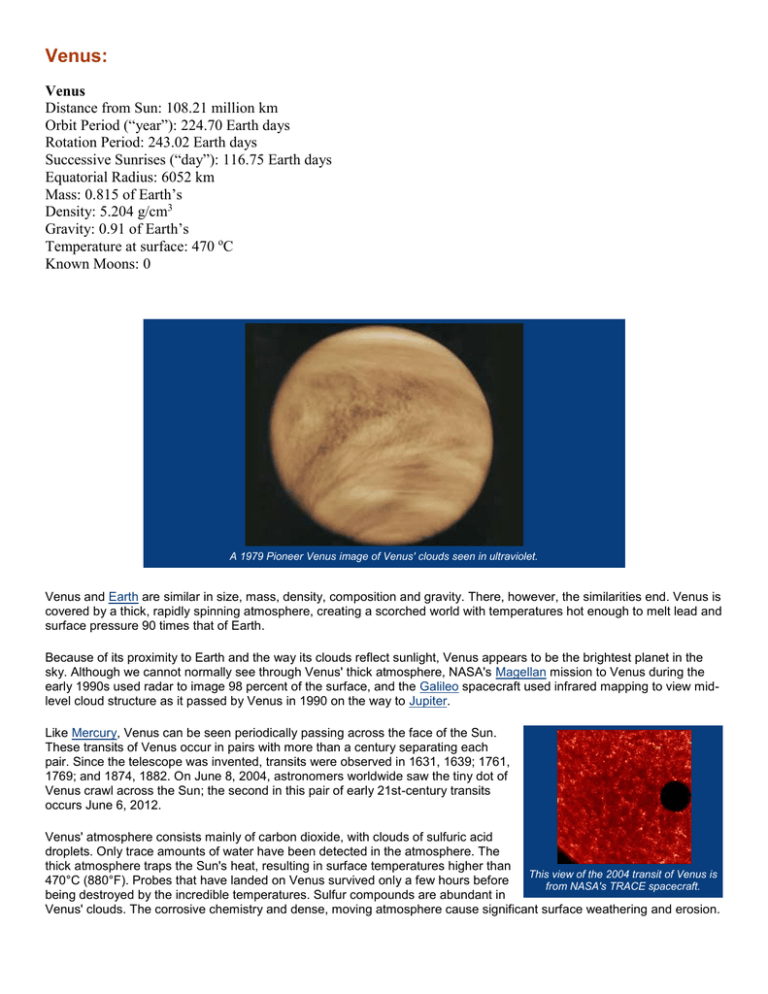
Venus: Venus Distance from Sun: 108.21 million km Orbit Period (“year”): 224.70 Earth days Rotation Period: 243.02 Earth days Successive Sunrises (“day”): 116.75 Earth days Equatorial Radius: 6052 km Mass: 0.815 of Earth’s Density: 5.204 g/cm3 Gravity: 0.91 of Earth’s Temperature at surface: 470 oC Known Moons: 0 A 1979 Pioneer Venus image of Venus' clouds seen in ultraviolet. Venus and Earth are similar in size, mass, density, composition and gravity. There, however, the similarities end. Venus is covered by a thick, rapidly spinning atmosphere, creating a scorched world with temperatures hot enough to melt lead and surface pressure 90 times that of Earth. Because of its proximity to Earth and the way its clouds reflect sunlight, Venus appears to be the brightest planet in the sky. Although we cannot normally see through Venus' thick atmosphere, NASA's Magellan mission to Venus during the early 1990s used radar to image 98 percent of the surface, and the Galileo spacecraft used infrared mapping to view midlevel cloud structure as it passed by Venus in 1990 on the way to Jupiter. Like Mercury, Venus can be seen periodically passing across the face of the Sun. These transits of Venus occur in pairs with more than a century separating each pair. Since the telescope was invented, transits were observed in 1631, 1639; 1761, 1769; and 1874, 1882. On June 8, 2004, astronomers worldwide saw the tiny dot of Venus crawl across the Sun; the second in this pair of early 21st-century transits occurs June 6, 2012. Venus' atmosphere consists mainly of carbon dioxide, with clouds of sulfuric acid droplets. Only trace amounts of water have been detected in the atmosphere. The thick atmosphere traps the Sun's heat, resulting in surface temperatures higher than This view of the 2004 transit of Venus is 470°C (880°F). Probes that have landed on Venus survived only a few hours before from NASA's TRACE spacecraft. being destroyed by the incredible temperatures. Sulfur compounds are abundant in Venus' clouds. The corrosive chemistry and dense, moving atmosphere cause significant surface weathering and erosion. The Venusian year (orbital period) is about 225 Earth days long, while the planet's rotation period is 243 Earth days, making a Venus day about 117 Earth days long. Venus rotates retrograde (east to west) compared with Earth's prograde (west to east) rotation. Seen from Venus, the Sun would rise in the west and set in the east. As Venus moves forward in its solar orbit while slowly rotating backwards on its axis, the top level of cloud layers zips around the planet every four Earth days, driven by hurricane-force winds traveling at about 360 kilometers (224 miles) per hour. The wind speeds within the clouds decrease with cloud height, and winds at the surface are estimated to be just a few kilometers per hour. How this atmospheric super-rotation forms and is maintained continues to be a topic of scientific investigation. Atmospheric lightning bursts, long suspected by scientists, were finally confirmed in 2007 by the European Venus Express orbiter. On Earth, Jupiter, and Saturn, lightning is associated with water clouds, but on Venus, it is associated with clouds of sulfuric acid. Radar images of the surface show wind streaks and sand dunes. Craters smaller than 1.5 to 2 kilometers (0.9 to 1.2 miles) across do not exist on Venus because small meteors burn up in the dense atmosphere before they reach the surface. It is thought that Venus was completely resurfaced by volcanic activity 300 to 500 million years ago. More than 1,000 volcanoes or volcanic centers larger than 20 kilometers (12 miles) in diameter dot the surface. Volcanic flows have produced long, sinuous channels extending for hundreds of kilometers. Venus has two large highland areas - Ishtar Terra, about the size of Australia, in the north polar region; and Aphrodite Terra, about the size of South America, straddling the equator and extending for almost 10,000 kilometers (6,000 miles). Maxwell Montes, the highest mountain on Venus and comparable to Mount Everest on Earth, is at the eastern edge of Ishtar Terra. Magellan radar images were used to create this threedimensional view of Venus' Maat Mons volcano. Venus has an iron core that is approximately 3,000 kilometers (1,200 miles) in radius. Venus has no global magnetic field - though its core iron content is similar to that of Earth, Venus rotates too slowly to generate a magnetic field similar to Earth's. How Venus Got its Name Venus is named for the ancient Roman goddess of love and beauty. Venus is the Roman counterpart to Aphrodite, the Greek goddess of love and beauty. It is believed Venus was named for the most beautiful of the ancient gods because it shone the brightest of the five planets known to ancient astronomers. Other civilizations have named it for their god or goddess of love/war. Significant Dates 650 AD: Mayan astronomers make detailed observations of Venus, leading to a highly accurate calendar. 1761-1769: Two European expeditions to watch Venus cross in front of the Sun lead to the first good estimate of the Sun's distance from Earth. 1962: NASA's Mariner 2 reaches Venus and reveals the planet's extreme surface temperatures. It is the first spacecraft to send back information from another planet. 1970: The Soviet Union's Venera 7 sends back 23 minutes of data from the surface of Venus. It is the first spacecraft to successfully land on another planet. 1990-1994: NASA's Magellan spacecraft, in orbit around Venus, uses radar to map 98 percent of the planet's surface. 2005: The European Space Agency launches Venus Express to study the atmosphere and plasma environment of Venus from orbit. From: http://sse.jpl.nasa.gov/planets/index.cfm


